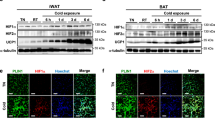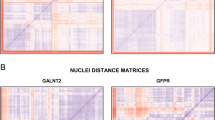Abstract
Objectives:
To investigate the impact of transient (2–4 h) hypoxia on metabolic reprogramming of adipocytes.
Methods:
The impact of transient hypoxia on metabolic reprogramming was investigated in 3T3-L1 cells before and after differentiation. Glucose uptake, fatty acid oxidation, lipolysis and mitochondria were examined to determine the hypoxia effects. Preadipocytes were exposed to transient hypoxia (4 h day−1) in the course of differentiation. Insulin sensitivity and triglyceride (TG) accumulation was examined in the cells at the end of differentiation to determine the reprogramming effects. AMP-activated protein kinase (AMPK) activity and gene expression were determined by quantitative reverse transcriptase-PCR and western blotting in search for mechanism of the reprogramming.
Results:
In acute response to hypoxia, adipocytes exhibited an increase in insulin-dependent and -independent glucose uptake. Fatty acid β-oxidation and pyruvate dehydrogenase activity were decreased. Multiple exposures of differentiating adipocytes to transient hypoxia enhanced insulin signaling, TG accumulation and expression of antioxidant genes in differentiated adipocytes in the absence of hypoxia. The metabolic memory was associated with elevated AMPK activity and gene expression (GLUT1, PGC-1α, PPARγ, SREBP, NRF-1, ESRRα, LPL). The enhanced insulin sensitivity was blocked by an AMPK inhibitor.
Conclusions:
Repeated exposure of differentiating adipocytes to transient hypoxia is able to reprogram the cells for increased TG accumulation and enhanced insulin sensitivity. The metabolic alterations were observed in postdifferentiated cells under normoxia. The reprogramming involves AMPK activation and gene expression in the metabolic pathways in cytosol and mitochondria.
This is a preview of subscription content, access via your institution
Access options
Subscribe to this journal
Receive 12 print issues and online access
$259.00 per year
only $21.58 per issue
Buy this article
- Purchase on Springer Link
- Instant access to full article PDF
Prices may be subject to local taxes which are calculated during checkout







Similar content being viewed by others
References
Ye J . Emerging role of adipose tissue hypoxia in obesity and insulin resistance. Int J Obes 2009; 33: 54–66.
Trayhurn P . Hypoxia and adipose tissue function and dysfunction in obesity. Physiol Rev 2013; 93: 1–21.
Goossens GH, Bizzarri A, Venteclef N, Essers Y, Cleutjens JP, Konings E et al. Increased adipose tissue oxygen tension in obese compared with lean men is accompanied by insulin resistance, impaired adipose tissue capillarization, and inflammation. Circulation 2011; 124: 67–76.
Ambrosini G, Nath AK, Sierra-Honigmann MR, Flores-Riveros J . Transcriptional activation of the human leptin gene in response to hypoxia. Involvement of hypoxia-inducible factor 1. J Biol Chem 2002; 277: 34601–34609.
Grosfeld A, Zilberfarb V, Turban S, Andre J, Guerre-Millo M, Issad T . Hypoxia increases leptin expression in human PAZ6 adipose cells. Diabetologia 2002; 45: 527–530.
Wang B, Wood IS, Trayhurn P . Hypoxia induces leptin gene expression and secretion in human preadipocytes: differential effects of hypoxia on adipokine expression by preadipocytes. J Endocrinol 2008; 198: 127–134.
Ye J, Gao Z, Yin J, He H . Hypoxia is a potential risk factor for chronic inflammation and adiponectin reduction in adipose tissue of ob/ob and dietary obese mice. Am J Physiol Endocrinol Metab 2007; 293: E1118–E1128.
Hosogai N, Fukuhara A, Oshima K, Miyata Y, Tanaka S, Segawa K et al. Adipose tissue hypoxia in obesity and its impact on adipocytokine dysregulation. Diabetes 2007; 56: 901–911.
Rausch ME, Weisberg S, Vardhana P, Tortoriello DV . Obesity in C57BL/6 J mice is characterized by adipose tissue hypoxia and cytotoxic T-cell infiltration. Int J Obes (Lond) 2008; 32: 451–463.
Yin J, Gao Z, He Q, Ye J . Role of hypoxia in obesity-induced disorders of glucose and lipid metabolism in adipose tissue. Am J Physiol Endocrinol Metab 2009; 296: E333–E342.
Ye J, McGuinness OP . Inflammation during obesity is not all bad: Evidence from animal and human studies. Am J Physiol Endocrinol Metab 2013; 304: E466–E477.
Johnson AM, Olefsky JM . The origins and drivers of insulin resistance. Cell 2013; 152: 673–684.
Regazzetti C, Peraldi P, Gremeaux T, Najem-Lendom R, Ben-Sahra I, Cormont M et al. Hypoxia decreases insulin signaling pathways in adipocytes. Diabetes 2009; 58: 95–103.
Kim KH, Song MJ, Chung J, Park H, Kim JB . Hypoxia inhibits adipocyte differentiation in a HDAC-independent manner. Biochem Biophys Res Commun 2005; 333: 1178–1184.
Yun Z, Maecker HL, Johnson RS, Giaccia AJ . Inhibition of PPAR gamma 2 gene expression by the HIF-1-regulated gene DEC1/Stra13: a mechanism for regulation of adipogenesis by hypoxia. Dev Cell 2002; 2: 331–341.
Ye J . Adipose tissue vascularization: its role in chronic inflammation. Curr Diab Rep 2011; 11: 203–210.
Lee Yun S, Kim J-w, Osborne O, Oh Da Y, Sasik R, Schenk S et al. Increased adipocyte O2 consumption triggers HIF-1α, causing inflammation and insulin resistance in obesity. Cell 2014; 157: 1339–1352.
Gao Z, He Q, Peng B, Chiao PJ, Ye J . Regulation of nuclear translocation of HDAC3 by IkBa is required for tumor necrosis factor inhibition of peroxisome proliferator-activated receptor {gamma} function. J Biol Chem 2006; 281: 4540–4547.
Jiang B, Ren C, Li Y, Lu Y, Li W, Wu Y et al. Sodium sulfite is a potential hypoxia inducer that mimics hypoxic stress in Caenorhabditis elegans. J Biol Inorg Chem 2010; 16: 267–274.
Gao Z, Zhang X, Zuberi A, Hwang D, Quon MJ, Lefevre M et al. Inhibition of insulin sensitivity by free fatty acids requires activation of multiple serine kinases in 3T3-L1 adipocytes. Mol Endocrinol 2004; 18: 2024–2034.
Gao Z, Yin J, Zhang J, Pope CR, Ward RE, Martin RJ et al. Butyrate improves insulin sensitivity and increases energy expenditure in mice. Diabetes 2009; 58: 1509–1517.
Lin J, Yang R, Tarr PT, Wu PH, Handschin C, Li S et al. Hyperlipidemic effects of dietary saturated fats mediated through PGC-1beta coactivation of SREBP. Cell 2005; 120: 261–273.
Xue Y, Petrovic N, Cao R, Larsson O, Lim S, Chen S et al. Hypoxia-independent angiogenesis in adipose tissues during cold acclimation. Cell Metab 2009; 9: 99–109.
Krishnan J, Suter M, Windak R, Krebs T, Felley A, Montessuit C et al. Activation of a HIF1alpha-PPARgamma axis underlies the integration of glycolytic and lipid anabolic pathways in pathologic cardiac hypertrophy. Cell Metab 2009; 9: 512–524.
Ong JM, Kern PA . The role of glucose and glycosylation in the regulation of lipoprotein lipase synthesis and secretion in rat adipocytes. J Biol Chem 1989; 264: 3177–3182.
Jiang X, Ye X, Guo W, Lu H, Gao Z . Inhibition of HDAC3 promotes ligand-independent PPARgamma activation by protein acetylation. J Mol Endocrinol 2014; 53: 191–200.
Choi JH, Banks AS, Estall JL, Kajimura S, Bostrom P, Laznik D et al. Anti-diabetic drugs inhibit obesity-linked phosphorylation of PPARgamma by Cdk5. Nature 2010; 466: 451–456.
Musi N, Goodyear LJ . AMP-activated protein kinase and muscle glucose uptake. Acta Physiol Scand 2003; 178: 337–345.
Russell RR 3rd, Bergeron R, Shulman GI, Young LH . Translocation of myocardial GLUT-4 and increased glucose uptake through activation of AMPK by AICAR. Am J Physiol 1999; 277: H643–H649.
Fisher JS, Gao J, Han DH, Holloszy JO, Nolte LA . Activation of AMP kinase enhances sensitivity of muscle glucose transport to insulin. Am J Physiol Endocrinol Metab 2002; 282: E18–E23.
Jager S, Handschin C, St-Pierre J, Spiegelman BM . AMP-activated protein kinase (AMPK) action in skeletal muscle via direct phosphorylation of PGC-1alpha. Proc Natl Acad Sci USA 2007; 104: 12017–12022.
Denko NC . Hypoxia, HIF1 and glucose metabolism in the solid tumour. Nat Rev Cancer 2008; 8: 705–713.
Acknowledgements
This work was supported by National Institutes of Health grant (DK068036 and DK085495) to JY, National Natural Science Funds for Distinguished Young Scholar of China (81025005) and Changjiang Scholars and Innovative Research Team in University of China (985 project IRT 0947) to JW. The qRT-PCR assay was performed in core facility supported by NIH grant (2P30DK072476). The funders had no role in study design, data collection and analysis, decision to publish or preparation of the manuscript.
Author contributions
HL, ZG and ZZ performed the experiments. JY and JW designed the study and wrote the manuscript. JY is fully responsible for this article. All authors read and approved the final manuscript.
Author information
Authors and Affiliations
Corresponding authors
Ethics declarations
Competing interests
The authors declare no conflict of interest.
Rights and permissions
About this article
Cite this article
Lu, H., Gao, Z., Zhao, Z. et al. Transient hypoxia reprograms differentiating adipocytes for enhanced insulin sensitivity and triglyceride accumulation. Int J Obes 40, 121–128 (2016). https://doi.org/10.1038/ijo.2015.137
Received:
Revised:
Accepted:
Published:
Issue Date:
DOI: https://doi.org/10.1038/ijo.2015.137
This article is cited by
-
The role of hypoxia-inducible factors in metabolic diseases
Nature Reviews Endocrinology (2019)



